Experimental and Numerical Study of Edge Defects When Turning 17vol.% SiCp/2009Al Composites
Abstract
:1. Introduction
2. Finite Element Modeling Procedures
3. Materials and Experimental Procedures
4. Results and Discussion
4.1. Formation Mechanism of Edge Defects
4.2. Edge Defects
4.3. Influence of Cutting Parameters on the Sizes of Edge Defects
5. Conclusions
Author Contributions
Funding
Conflicts of Interest
References
- Liu, Z.Y.; Wang, Q.Z.; Xiao, B.L.; Ma, Z.Y. Clustering model on the tensile strength of PM processed SiCp/Al composites. Compos. Part A Appl. Sci. Manuf. 2010, 41, 1686–1692. [Google Scholar] [CrossRef]
- Xiang, J.F.; Xie, L.J.; Gao, F.N.; Zhang, Y.; Yi, J.; Wang, T.; Pang, S.Q.; Wang, X.B. On multi-objective based plastic constitutive modelling methodology and numerical validation in small-hole drilling of Al6063/SiCp composites. Materials 2018, 11, 97. [Google Scholar] [CrossRef] [PubMed]
- Balasubramanian, I.; Maheswaran, R. Effect of inclusion of SiC particulates on the mechanical resistance behaviour of stir-cast AA6063/SiC composites. Mater. Des. 2015, 65, 511–520. [Google Scholar] [CrossRef]
- Cui, Y.; Jin, T.Z.; Cao, L.G.; Liu, F.B. Aging behavior of high volume fraction SiCp/Al composites fabricated by pressureless infiltration. J. Alloys Compd. 2016, 681, 233–239. [Google Scholar] [CrossRef]
- Hu, F.Q.; Cao, F.Y.; Song, B.Y.; Hou, P.J.; Zhang, Y.; Chen, K.; Wei, J.Q. Surface properties of SiCp/Al composites by powder-mixed EDM. Procedia CIRP 2013, 6, 101–106. [Google Scholar] [CrossRef]
- Sahin, Y.; Sur, G. The effect of Al2O3, TiN and Ti (C,N) based CVD coatings on tool wear in machining metal matrix composites. Surf. Coat. Technol. 2004, 179, 349–355. [Google Scholar] [CrossRef]
- Xiang, J.F.; Xie, L.J.; Hu, X.; Peng, S.; Wang, T. Investigation of cutting forces, surface integrity, and tool wear when high-speed milling of high-volume fraction SiCp/Al6063 composites in PCD tooling. Int. J. Adv. Manuf. Technol. 2018, 98, 1237–1251. [Google Scholar] [CrossRef]
- Xiang, J.F.; Pang, S.Q.; Xie, L.J.; Gao, F.N.; Hu, X.; Yi, J.; Hu, F. Mechanism-Based FE Simulation of Tool Wear in Diamond Drilling of SiCp/Al Composites. Materials 2018, 11, 252. [Google Scholar] [CrossRef] [PubMed]
- Di Ilio, A.; Paoletti, A. A comparison between conventional abrasives and superabrasives in grinding of SiC-aluminium composites. Int. J. Mach. Tools Manuf. 2000, 40, 173–184. [Google Scholar] [CrossRef]
- Xiang, J.F.; Xie, L.J.; Gao, F.N.; Yi, J.; Pang, S.Q.; Wang, X.B. Diamond tools wear in drilling of SiCp/Al matrix composites containing Copper. Ceram. Int. 2018, 44, 5341–5351. [Google Scholar] [CrossRef]
- Ge, Y.F.; Xu, J.H.; Yang, H.; Luo, S.B.; Fu, Y.C. Workpiece surface quality when ultra-precision turning of SiCp/Al composites. J. Mater. Process. Technol. 2008, 203, 166–175. [Google Scholar] [CrossRef]
- Pramanik, A.; Zhang, L.C.; Arsecularatne, J.A. Machining of metal matrix composites: Effect of ceramic particles on residual stress, surface roughness and chip formation. Int. J. Mach. Tools Manuf. 2008, 48, 1613–1625. [Google Scholar] [CrossRef] [Green Version]
- Dabade, U.A.; Joshi, S.S. Analysis of chip formation mechanism in machining of Al/SiCp metal matrix composites. J. Mater. Process. Technol. 2009, 209, 4704–4710. [Google Scholar] [CrossRef]
- Xiang, J.F.; Xie, L.J.; Hu, X.; Huo, S.Y.; Pang, S.Q.; Wang, X.B. Simulation and Experimental Research on Ultra-precision Turning of SiCp/Al Composites. Rare Met. Mater. Eng. 2019, 48, 1687–1696. [Google Scholar]
- Chern, G.L. Study on mechanisms of burr formation and edge breakout near the exit of orthogonal cutting. J. Mater. Process. Technol. 2006, 176, 152–157. [Google Scholar] [CrossRef]
- Chern, G.L. Study on a new turning method to simulate orthogonal cutting and to verify an edge breakout mode. Int. J. Adv. Manuf. Technol. 2005, 26, 965–969. [Google Scholar] [CrossRef]
- Ko, S.L.; Dornfeld, D.A. Burr formation and fracture in oblique cutting. J. Mater. Process. Technol. 1996, 62, 24–36. [Google Scholar] [CrossRef]
- Hashimura, M.; Ueda, K.; Dornfeld, D. Analysis of three-dimensional burr formation in oblique cutting. CIRP Ann. Manuf. Technol. 1995, 44, 27–30. [Google Scholar] [CrossRef]
- Gaitonde, V.N.; Karnik, S.R.; Rubio, J.C.; Correia, A.E.; Abrao, A.M.; Davim, J.P. Analysis of parametric influence on delamination in high-speed drilling of carbon fiber reinforced plastic composites. J. Mater. Process. Technol. 2008, 203, 431–438. [Google Scholar] [CrossRef]
- Tsao, C.C. Effect of induced bending moment (IBM) on critical thrust force for delamination in step drilling of composites. Int. J. Mach. Tools Manuf. 2012, 59, 1–5. [Google Scholar] [CrossRef]
- Tsao, C.C.; Hocheng, H. Effect of tool wear on delamination in drilling composite materials. Int. J. Mech. Sci. 2007, 49, 983–988. [Google Scholar] [CrossRef]
- Lazar, M.B.; Xirouchakis, P. Experimental analysis of drilling fiber reinforced composites. Int. J. Mach. Tools Manuf. 2011, 51, 937–946. [Google Scholar] [CrossRef]
- Arul, S.; Vijayaraghavan, L.; Malhotra, S.K.; Krishnamurthy, R. The effect of vibratory drilling on hole quality in polymeric composites. Int. J. Mach. Tools Manuf. 2006, 46, 252–259. [Google Scholar] [CrossRef]
- Tan, Y.Q.; Yang, D.M.; Sheng, Y. Discrete element method (DEM) modeling of fracture and damage in the machining process of polycrystalline SiC. J. Eur. Ceram. Soc. 2009, 29, 1029–1037. [Google Scholar] [CrossRef]
- Zhou, L.; Huang, Z.Y.; Wang, C.Z.; Zhang, X.X.; Xiao, B.L.; Ma, Z.Y. Constitutive flow behaviour and finite element simulation of hot rolling of SiCp/2009Al composite. Mech. Mater. 2016, 93, 32–42. [Google Scholar] [CrossRef]
- Xiang, J.F.; Xie, L.J.; Gao, F.N.; Yi, J.; Pang, S.Q. Methodology for dependence-based integrated constitutive modelling: An illustrative application to SiCp/Al composites. Ceram. Int. 2018, 44, 11765–11777. [Google Scholar] [CrossRef]
- Hooputra, H.; Gese, H.; Dell, H.; Werner, H. A comprehensive failure model for crashworthiness simulation of aluminum extrusions. Int. J. Crashworthiness 2004, 9, 449–464. [Google Scholar] [CrossRef]
- Zorev, N.N. Inter-relationship between shear processes occurring along tool face and shear plane in metal cutting. Int. Res. Prod. Eng. 1963, 49, 143–152. [Google Scholar]
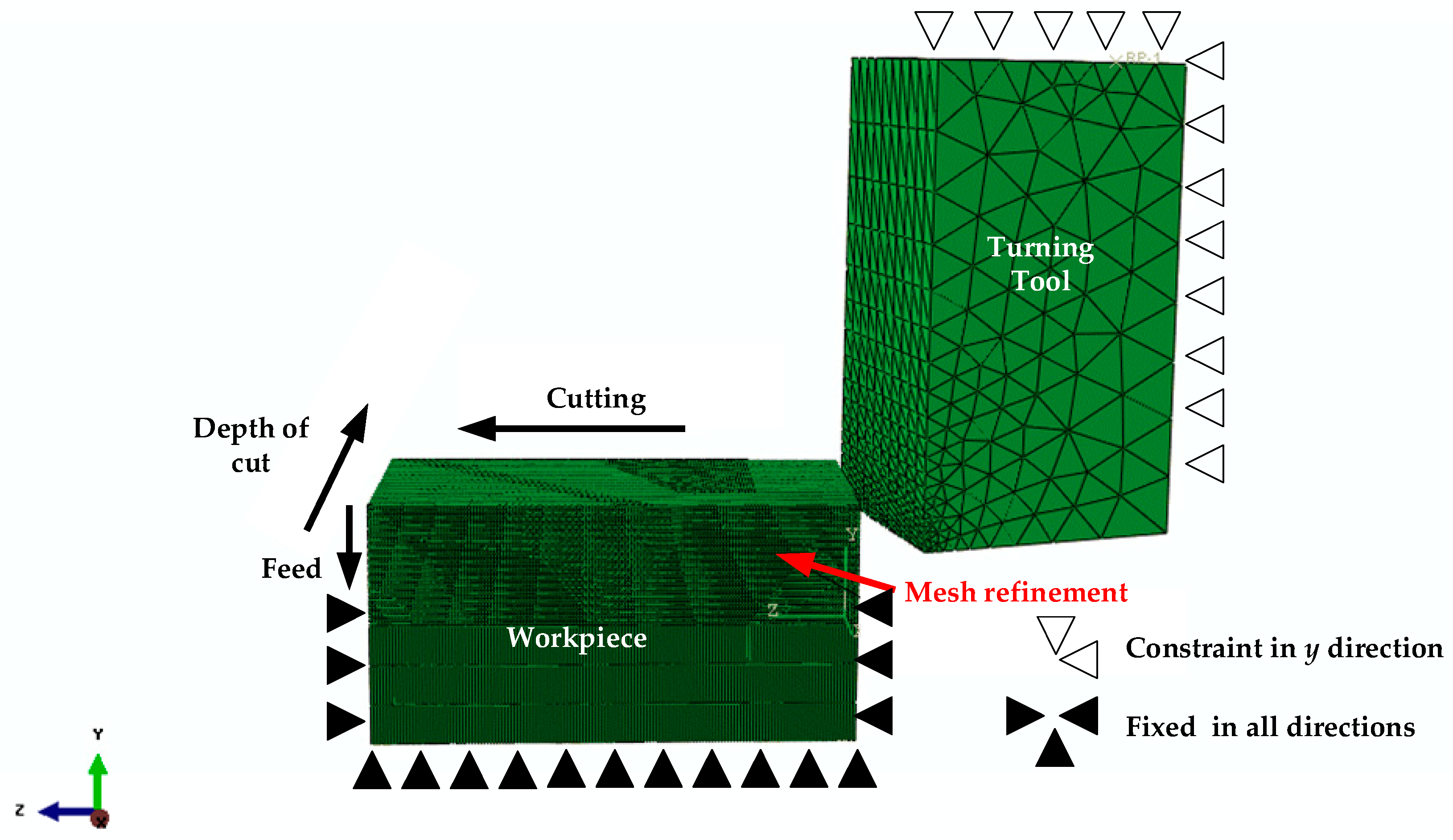
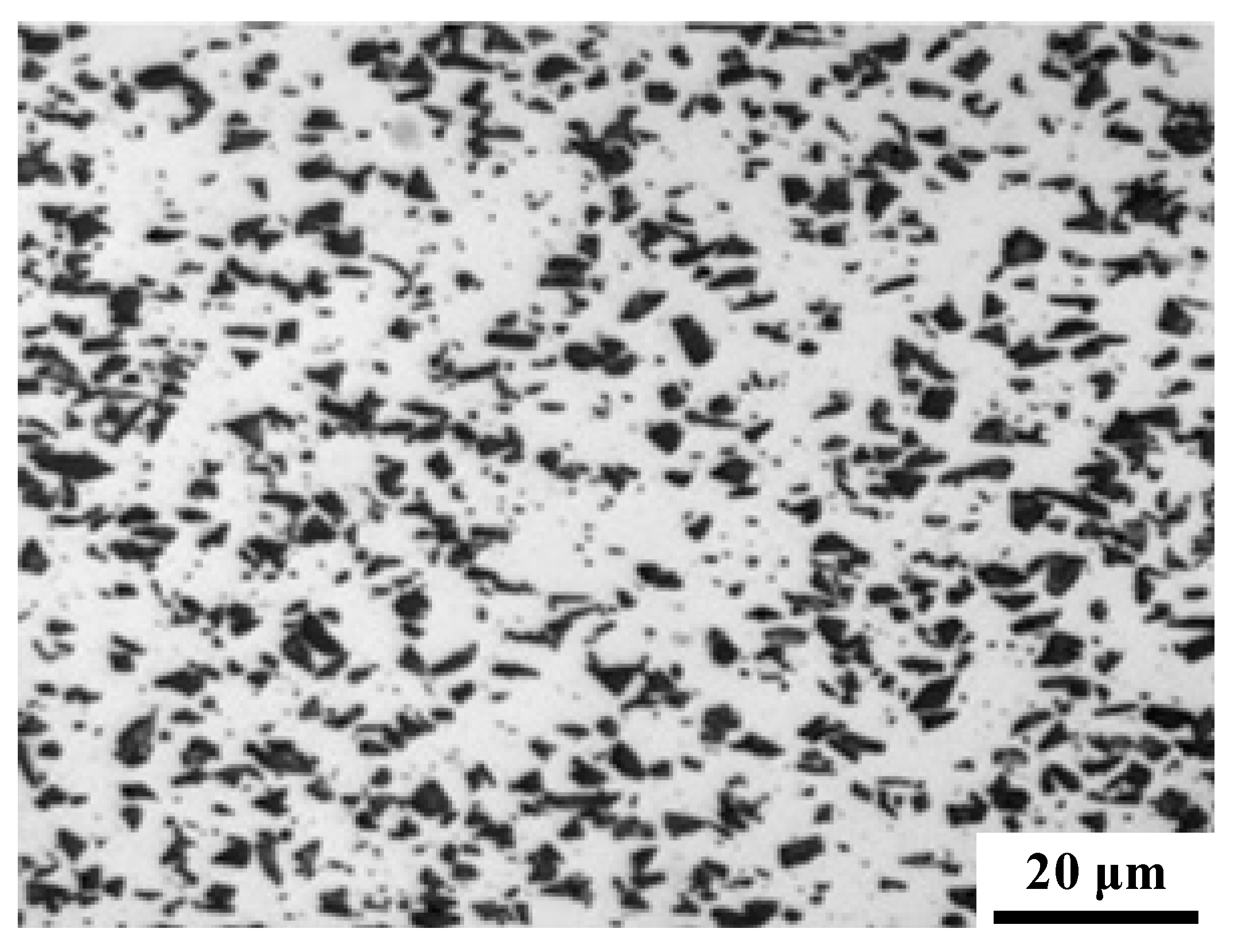
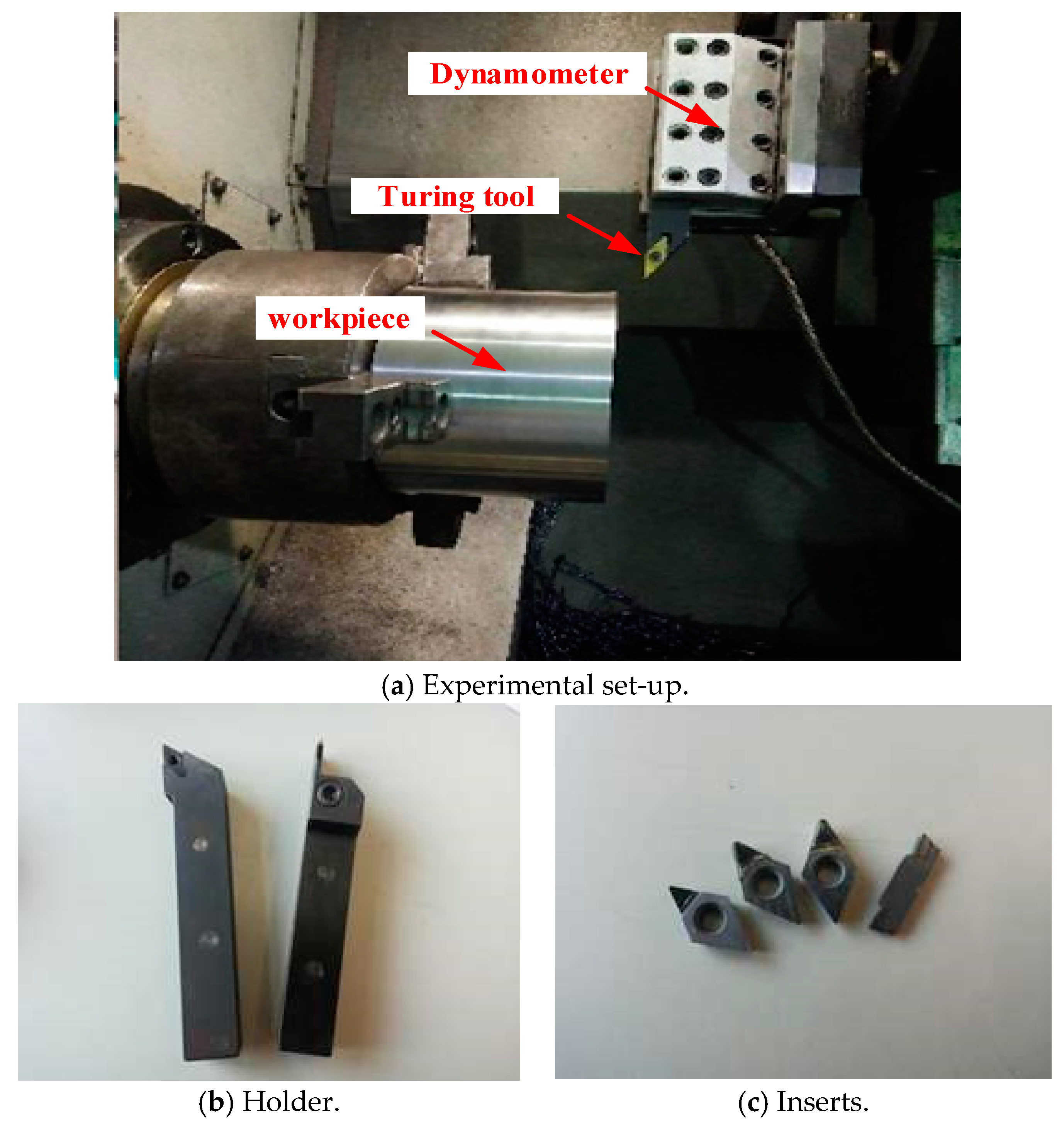
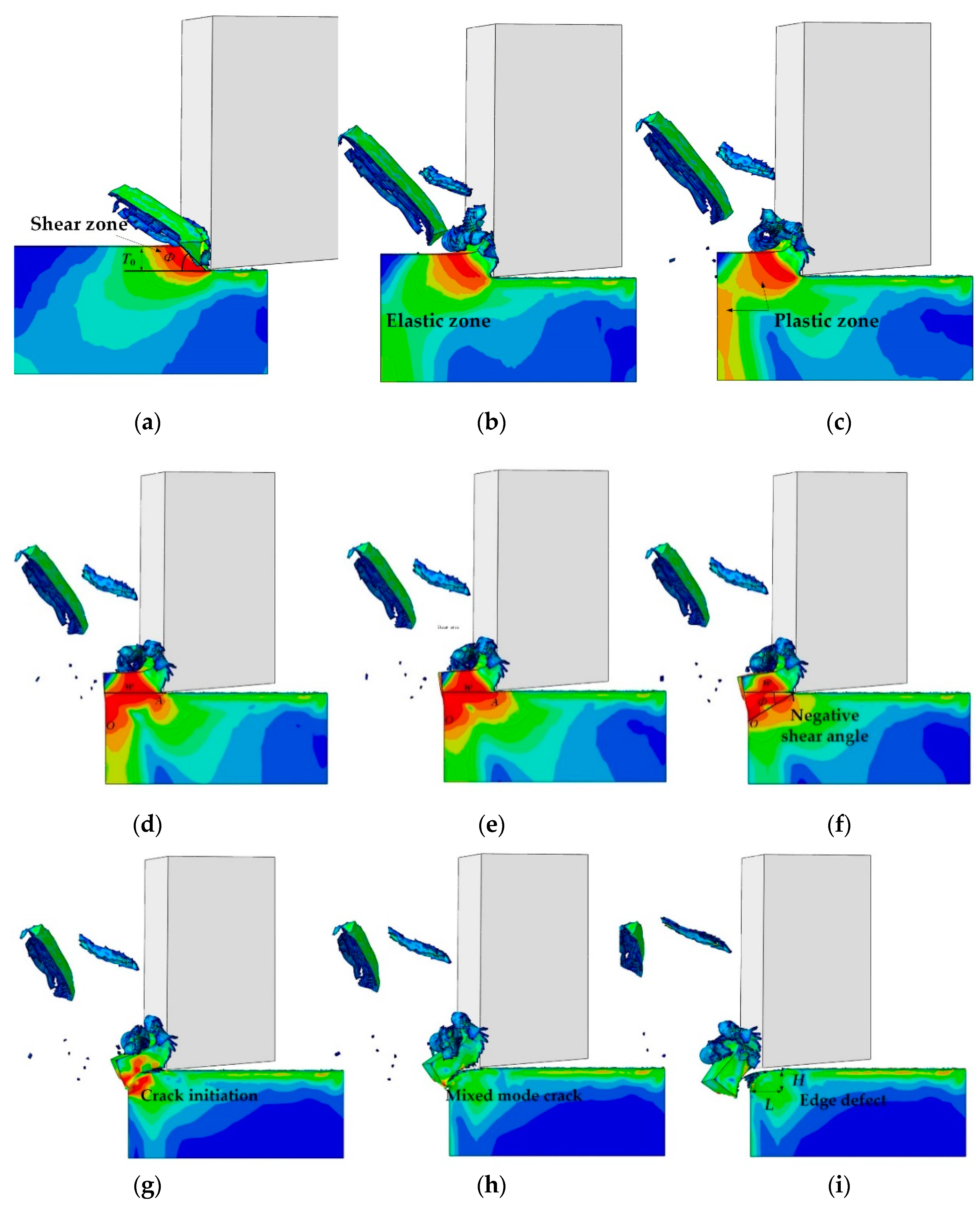

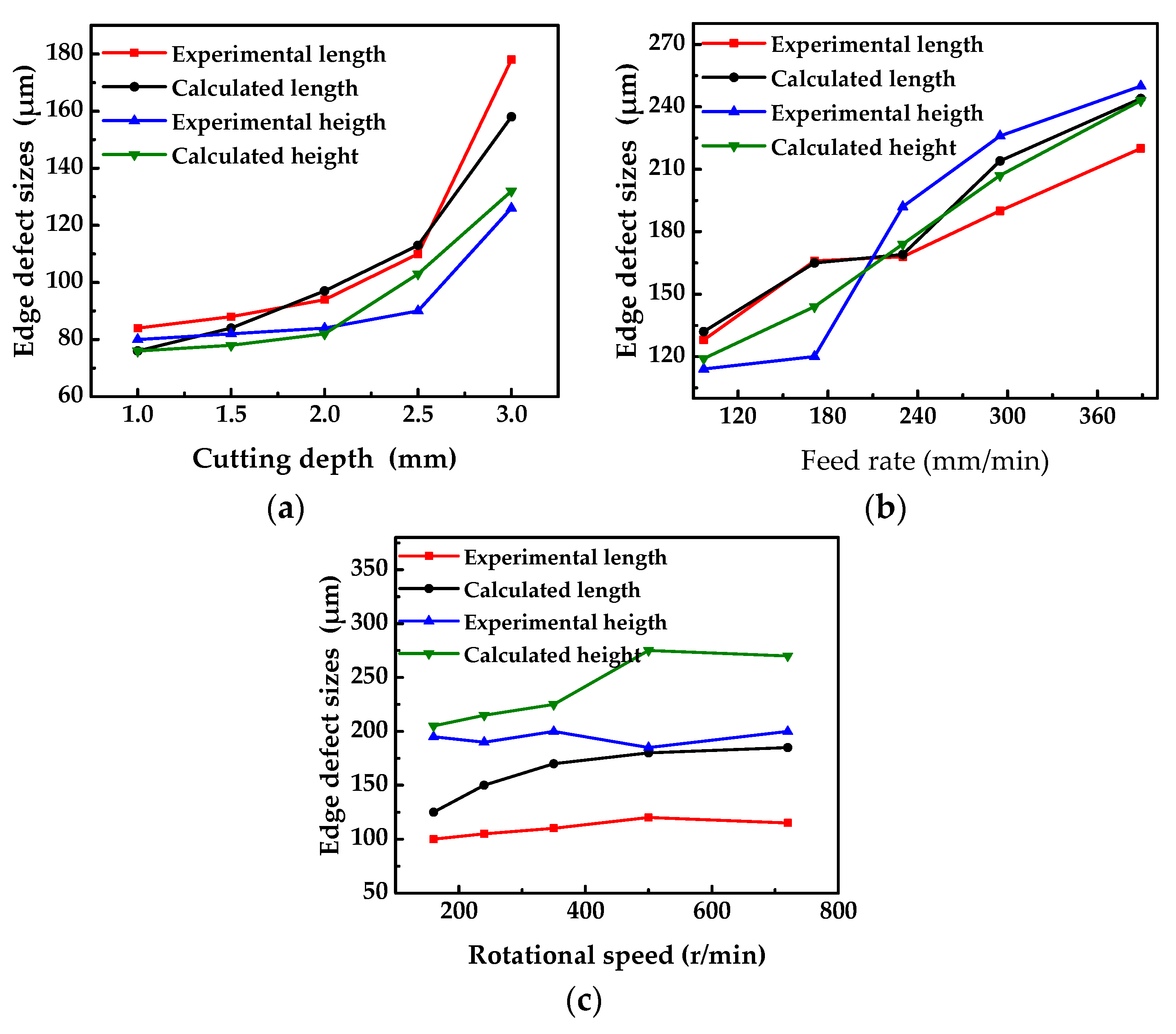
| Material Parameters | PCD Tools | 17vol.% SiCp/2009Al Composites |
|---|---|---|
| ρ, Density (kg/m3) | 3520 | 2940 |
| E, Elastic modulus (GPa) | 1147 | 258 |
| ν, Poisson’s ratio | 0.07 | 0.2 |
| κ, Thermal conductivity (W/m·K) | 2100 | 235 |
| Cp, Specific heat capacity (J/kg·K) | 525 | 850 |
| Items | Contents |
|---|---|
| Tools | |
| Insert material | Polycrystalline diamond (PCD CTH025) |
| Grain size, | 25 μm |
| Tool nose radius | 0.1 mm |
| Rake angle | 0° |
| Clearance angle | 10° |
| Inclination angle | 10° |
| Machining conditions | |
| Depth of cut (mm) | 1, 1.5, 2, 2.5, 3 |
| Feed rate (mm/min) | 97, 171, 230, 295, 389 |
| Rotational speed (r/min) | 160, 240, 350, 500, 720 |
| Machining environment | Dry |
© 2019 by the authors. Licensee MDPI, Basel, Switzerland. This article is an open access article distributed under the terms and conditions of the Creative Commons Attribution (CC BY) license (http://creativecommons.org/licenses/by/4.0/).
Share and Cite
Zhou, L.; Xiang, J.; Yi, J.; Gao, P.; Xie, J. Experimental and Numerical Study of Edge Defects When Turning 17vol.% SiCp/2009Al Composites. Appl. Sci. 2019, 9, 3817. https://doi.org/10.3390/app9183817
Zhou L, Xiang J, Yi J, Gao P, Xie J. Experimental and Numerical Study of Edge Defects When Turning 17vol.% SiCp/2009Al Composites. Applied Sciences. 2019; 9(18):3817. https://doi.org/10.3390/app9183817
Chicago/Turabian StyleZhou, Li, Junfeng Xiang, Jie Yi, Peng Gao, and Jiaqing Xie. 2019. "Experimental and Numerical Study of Edge Defects When Turning 17vol.% SiCp/2009Al Composites" Applied Sciences 9, no. 18: 3817. https://doi.org/10.3390/app9183817




